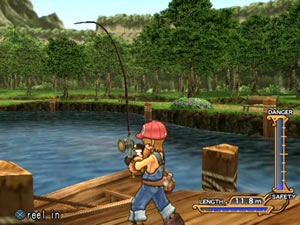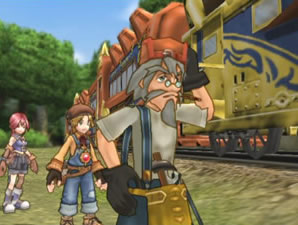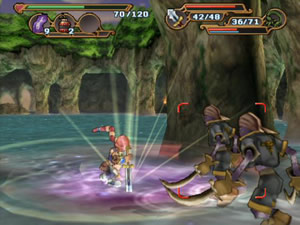Silver linings.
Maximilian, an earnest young boy with a knack for invention, fatefully crosses
paths one day with Monica, a sword-wielding princess from the future. She has
traveled back in time because important people and places have been disappearing
left and right thanks to an evil force futzing around with time travel.
If something never began, then it ceases to exist. Remember in Back to
the Future when Marty McFly starting fading away? That’s the idea. Together,
Max and Monica must restore the lost origin points, fixing the past to save
the future. And no, they don’t play any Check Berry songs.
Dark Cloud 2‘s origin point is the first Dark
Cloud, an interesting release for the PS2 that mixed Zelda combat,
randomized dungeons and town-creation into a decent RPG. The sequel improves
upon every facet of the original, yet ultimately it suffers from some of the
same problems as its forbear.
The game starts out a touch slow, easing you into the many different playable
genres. From dungeons and town construction to the new “inventing with photography”
system, the game is brimming with things to do.
The random dungeons are divided into floors, and one random monster on each
floor has the exit key. I don’t know why a monster would have a key or why monsters
always carry money and items, but more importantly, you have to rob them and
beat them to death.
After completing one floor, the game can be saved, and it’s onward to the
next floor or a complete exit from the dungeon to run other errands. Despite
the dungeon label, there is a visible, conscience effort to make each “dungeon”
have a different look and feel.
The main disadvantage of randomized dungeons is that it feels less like a
truly contiguous world. Rather than looking at the lush scenery, I find myself
fixated on the little inset map, almost as if I’m still playing the original
DOS version of
Rogue. Overall, these segments feel serial in nature, as you complete each
floor of the dungeon one by one.
Random dungeons do provide opportunities to build up your character statistics,
which is especially fun for stat-minded players. As an incentive to get more
play out of each floor, various challenges are listed. Some challenges require
you to conquer the dungeon in a specific form or fight with only a certain item
The combat is a cross between Zelda and Phantasy
Star Online. After locking onto an opponent, Max and Monica can slash, shoot,
charge and block. Even though Ocarina of Time‘s combat is simpler in
comparison, the timing was more readily apparent. Dark Cloud 2 has smaller
windows of opportunity to fit in a block, and the varying damage by enemies
means you can be quickly caught by surprise for an unexpected death.
Max and Monica each have alternate forms, bringing the total number of playable
characters to four. The Ridepod, Max’s robotic ride, is my favorite form and
really livens up the combat. The experience points earned while in the Ridepod
go directly towards buying upgrades, from heavy blasting artillery and caterpillar
treads to dual katanas. Monica has the ability to turn into selected enemy characters.
Amusingly, while in this form, she can talk to other creatures of the same species.
It seems like monsters have much to complain about – as well they should, because
they keep getting robbed and beaten up.
In each new chapter of the game, you’ll find an area that has been beaten
down into an empty plain. The origin point has been erased, and you must recreate
the point by constructing a town that fits certain criteria. Building instructions
for these towns can be found scattered within the dungeons, locked within Geostones.
The Georama town constructing system feels more fleshed out and more open-ended
than in the original.
 Another
Another
open-ended addition is the Photography Invention system. Max is given a camera
that lets him “collect” an item by taking a photograph of it. After you’ve collected
a big list of photos, you put three of them together to create the blueprints
for an invention. There are hints dropped throughout the game on what three
items to put together in order to come up with something.
Despite the expansive list of special items to create, I wish the three items
that make an invention actually had more logical real-world thought behind them.
Coming up with an invention wholly on your own is almost utterly random. The
game helps out a bit – if you can get at least two of the three correct, some
clues will be provided on the third part. It’s a cool game idea, but it’s a
bit too restricted to really play correctly.
At the very least, running around and taking photos forces you notice the impressive
attention to detail. In one shop, I found a Dali-esque melting clock, drooping
atop a cabinet. Dark Cloud 2‘s cel-shaded style paints a very pretty
picture; it’s a solid look filled with detail and color. The consistent style
pushes the pleasant storybook atmosphere of the game.
While the music is rich and filled with emotional touches, it gets repetitive.
The voices are well cast, but the writing behind the dialogue varies. For example,
one character has a long drawl to everything he says; it’s overdone and adds
little to his character.
Once the game finally gets up to speed, it devolves into cycles of fighting
simply to earn gold, which is used to buy building pieces for towns. The town
parts are constructed to trigger events in the future that lead into boss battles,
and thus leading towards more dungeons to explore.
Again, Dark Cloud 2 is very serial in nature. It’s a game you can pick
up and play for a few hours, stomping though a few dungeon floors, trying to
solve a problem or two, but after a while it meanders towards repetition. In
truth, the game is filled with innumerable challenges, likable characters and
a high production value. But beneath the surface, the lightweight story and
characters combined with the almost rigidly episodic game flow still hold it
back. It’s a marked improvement, but the standards have gone up as well.

-
Improves upon the original
-
So many things to do
-
The Ridepod!
-
Storybook graphics
-
Slow to start
-
Repetition
-
Lightweight story and characters







